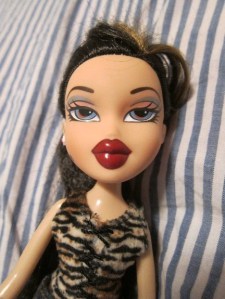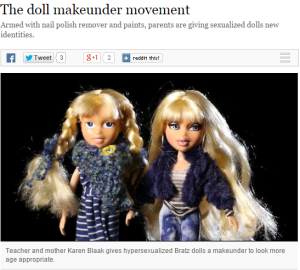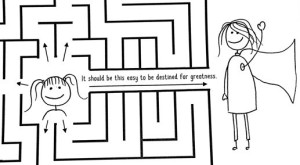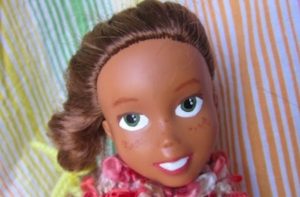The Normalization of Objectification and the Daunting Self-Imposed Greatness
The following is cross-posted by author Karen Blaak. You can find her at her blog, Bright Dolls.
If you’d like to help this conversation grow, share this article, buy a Bright Doll, and read more and share more at www.brightdolls.wordpress.com, or follow me on Twitter and Facebook.
 We value and perpetuate the labels placed upon us in the media. And women must not choose merely one label to live up to. As I flesh out my own self-esteem, I feel I am asked more and more (By me? By my students? Colleagues? Kids?) to live up to innumerable labels. I must embody and dominate each and every “Brand of Woman” in order to be most successful, even if “most successful” looks like personal happiness instead of ladder climbing.
We value and perpetuate the labels placed upon us in the media. And women must not choose merely one label to live up to. As I flesh out my own self-esteem, I feel I am asked more and more (By me? By my students? Colleagues? Kids?) to live up to innumerable labels. I must embody and dominate each and every “Brand of Woman” in order to be most successful, even if “most successful” looks like personal happiness instead of ladder climbing.
Expectations of Behaviour: we must be nagging bitches whose husbands must escape to their Neanderthalic Man Caves (thus proving that we must be civilized, above all else), we must be witty, we must be able to hold our own, we must not be too confident lest we intimidate, and so we try to be self-assured while making it look like we are insecure so as to remain humble.
Expectations of Expertise: we must, no matter how helpful our male counterparts are, be the homemakers, know what every book says about child rearing, maintain all appointments and family records, keep track of children’s wardrobes, have a degree, choose the family, choose the career, choose the yoga class, and still somehow sleep.
Expectations of Appearance: we must be beautiful but look like we haven’t tried, we must have it all together and look like we are not burned out. We must be made up, dressed down, thrifty, Pinteresty, and chevronned. We must, above anything, be sexy and desirable while we do all of the above.
We place these expectations upon ourselves, and I know my husband looks on with rolling eyes wondering why it’s all such a big deal for me to be everything at all times to all people.
I understand that we have to tone it down.
Unmaking hypersexualized dolls is one way to do so.
Let’s just put it on the table right at the onset: I am so thankful that hypersexaulized dolls exist. I’m glad for them. Because they exist, we have a vivid example of things gone too far. We can save them. We can talk about why. And, in doing so, we can teach a new generation of thinkers to believe they are worth so much more than what our culture has in store.
My mom simply would have not allowed me to play with them. But now that I and my peers are parents, avoidance isn’t our thing.
I’ll be the first to admit that I don’t know exactly how to navigate these waters, for inasmuch as they are not necessarily unchartered, the currents and waves muddy them. But navigate we must.
Why?
Hypersexualized dolls do everything to dredge up and reinforce the stereotypes that promote  backwards chauvinist/misogynist thinking:
backwards chauvinist/misogynist thinking:
- beauty is only skin deep
- to be beautiful, females must cover up natural beauty with consumerism
- a powerful female is one who knows how to lure the attention of men (thus her power is not in herself, but in her ability to dominate the real figures of power)
- to be a woman is to consume and indulge
- the evaluation of the self begins and ends with looking pretty
Our mentors – be they grandparents, peers, outdated customs and mores, and harmful images in the media – have allowed these stereotypes to exist and have effectively recorded in me a soundbite that continues to replay each day: I am never going to be good enough. I’m 33, educated, aware of it, and have the best game face out there. But that message is clear to me. I have to do more and be more than I am now.
I cannot allow life to replay like that for my kids.
Dove’s familiar Real Beauty campaign, the Always: Like A Girl campaign, new entrepreneurs producing toys like Goldie Blox, and good-hearted inspirational leaders like Sonia Singh of Tree Change Dolls all work to preserve our children’s self-esteem.
But if we’re all talking about it, what’s the big deal?
It’s simple: empowering our kids is easy while they’re young. The pressure is low, and the love is abundant. But when they enter the adult sphere – when they hit their adolescent years, when their worlds expand – they quickly learn that it’s harder to have worth based on merit, character, and acuity in a culture that values beauty and allure above all else.
I say it because I know it to be true: as a teen, I would dream of becoming a model because I wanted people to automatically assess and appreciate me upon first sight. To have to prove myself beyond that was daunting.
That was 20 years ago. How much harder is it for our girls today – with so much more access to and competition with the hypersexualized and stereotypical images that bombard us the moment we turn on the TV, scroll through social media, or leave our homes – to truly honour everything they’ve come to value about “strong women”?
You Ask: What about breaking the stereotype?
There is a dangerous trend wherein girls dress provocatively to “take back” their femininity – essentially saying “I can dress however I want because I’m a girl and shame on you for seeing me as a sexual being even though half my butt is hanging out my underwear-denim-shorts and my entire bra is showing.” There are two faults in this logic:
- That’s like saying I could get angry at anyone who sees me as a chicken despite my walking around in a chicken costume. Damn them! I’m a woman!
 As a woman, whether many of us would like to admit it or not, I am fully aware and use the precise and calculated gait, demeanour, and aura of control over men if that control would benefit me. We are conditioned from a young age to adopt this practice because it is easy. Manipulating the male gaze legitimizes my claim. To be blunt: despite being so aware of my need to be fair to myself, if it’s easier to gain power by way of using my sexuality, I’ll do it. I’m embarrassed to admit.
As a woman, whether many of us would like to admit it or not, I am fully aware and use the precise and calculated gait, demeanour, and aura of control over men if that control would benefit me. We are conditioned from a young age to adopt this practice because it is easy. Manipulating the male gaze legitimizes my claim. To be blunt: despite being so aware of my need to be fair to myself, if it’s easier to gain power by way of using my sexuality, I’ll do it. I’m embarrassed to admit.
The bottom line (no pun intended) is that if we want people to take us seriously, we must represent ourselves as we would want to be understood. If I want someone to take me seriously as a sexualized being, I’ll use my sexuality as my primary voice. But that’s not acceptable.
The reverse is the goal: if I want someone to see my intellectual worth, it’s a disservice to my efforts to allow my physicality to distract my audience.
Please do not assume that I’m blaming objectification or violence against women on those who choose to dress in ways that make them feel attractive. I’m very much blaming a defunct media representation that normalizes objectification and makes provocative dress not a choice, but an expected practice in order to feel attractive.
I do not mean to sound like an ancient, anti-tattoo, anti-piercing, prudish antiquate of my parents’ generation. The simple truth is that when we allow our kids to play with dolls that look like hookers, they may think this representation is acceptable for themselves as well. They may learn to value appearance before anything. They may learn that looking pretty matters more than anything else. It matters more than developing skills, speaking intelligently, and learning.
But….
Now is about the time that you’ll be rolling your eyes if you’re going to. If so, take a minute to answer these questions:
- what are you trying to accomplish when you hand a child a doll that looks like a hooker?
- what conversation could ensue when you use that hypersexualized doll to talk about self-esteem?
- what social ramifications could result from teaching her how to rescue the doll, and thereby, ideally, rescue herself?
While there is a time and a place for everything, integrating hypersexualized dolls into everyday play implies that hypersexualization is an everyday option, and thus implies that hypersexualized self-objectification is an expected norm when play becomes life. It’s critical that we model confidence. Whether we agree with it or not, without actively discussing the consequence of harmful images in the media on self-esteem, we passively accept that our society is hell-bent on a trajectory of unfair objectification.
The only legitimate reason for hypersexualized dolls to exist in our homes is to use them as opportunities to teach our kids about the appropriate, functional, and fundamental benefits of seeing ourselves as people who are beautiful without all the distractions. We must build self-esteem instead of providing opportunities for our kids to believe they can never measure up.
When we de-hypersexualize dolls, we thus imply that it’s never too late to restore a healthy body image when play becomes life.
You say: I wear tonnes of make-up and I’m confident. Fashion is fun! You’re reading too much into it!
Maybe. But not at all.
Here’s the deal: it shouldn’t be “fun” for pleather, faux fur, and hooker boots to be the cornerstone of childhood doll wardrobes. It shouldn’t be “fun” to be seen as an object first and a person second. And while you may disagree that hypersexualized dolls normalize objectification, when you are valued for only one part of yourself – your appearance – it undervalues all of the other parts including your abilities, ideas, and voice, all of which are worth more than feeling confident behind make-up. Confidence is knowing how to be beautiful without hiding behind everything that undoes beauty. Confidence is a smile and an idea and a belief and a voice.
“Pretty Girl” is a Nail in the Confidence Coffin
While it’s obvious that those with vision pass judgement based on how others look, those with mouths, however, must not necessarily speak each and every evaluation.
I have 4-year-old boy/girl twins, and it is simply not fair that my daughter is repeatedly told that her value, first and foremost, is in her appearance. My son will never have to deal with the heavy expectations that the girl must bear, for before she can even be taken seriously as an intellectual or person with any other talent than looking pretty, she must first past the “pretty” test.
Still.
 I cringe at the comments my girl receives about her pretty dress and her pretty hair and her pretty eyes. And I cringe a little less when the boy receives comments about his beaming grin as well; he’ll be fine and will be taken seriously beyond his beaming grin because our culture does not factor in these same value judgements made about boys – these same grating and consistently-verbalized evaluations that are so expected, accepted, and pathetically repeated of females. And as a proud and completely objective mom (right?), I’m pretty confident that my twins are of exceptional and equal beauty. But I break when I hear their beauty praised before their brains.
I cringe at the comments my girl receives about her pretty dress and her pretty hair and her pretty eyes. And I cringe a little less when the boy receives comments about his beaming grin as well; he’ll be fine and will be taken seriously beyond his beaming grin because our culture does not factor in these same value judgements made about boys – these same grating and consistently-verbalized evaluations that are so expected, accepted, and pathetically repeated of females. And as a proud and completely objective mom (right?), I’m pretty confident that my twins are of exceptional and equal beauty. But I break when I hear their beauty praised before their brains.
A simple, “you look like you have big ideas” would suffice. But, no. “You’re pretty” is the first message they hear.
I said earlier that I don’t really know how to navigate these waters. My daughter wants everything to sparkle; she wants only princess songs when I sing to her, and she wants to wear the biggest dresses I can find (or make) for her. And while I try to help her realize her beautiful dreams provided she also is willing to roll in the mud while wearing that frilly dress, I pair it with “all princesses are helpful” and “princesses are brave.” Other than that and her observations of me wiping whorish makeup off a hypersexualized doll, I don’t know what to do.
But the unavoidable messaging is clear because hypersexualization trumps it all: be as clever and fair to  yourself as you want, but at the end of the day, your worth is in your beauty.
yourself as you want, but at the end of the day, your worth is in your beauty.
There IS a solution:
Here’s how I know my efforts are not in vain. It’s all working:
When I was interviewed by the Toronto Star, my daughter (and no, not my son) was asked what she thought of an original Bratz doll. She called her “beautiful.”
The beginning and end of her evaluation of this doll was purely based on her physical appearance.
She qualified a made-under version of the same doll as “a doctor” and The Toronto Star quotes her saying that the made-under doll “looks like an angel.” No longer is the evaluation based on appearances; all the appearance does is inform of what else this doll is about.
When I was interviewed by Fairchild TV, my daughter said the doll was “an astronaut.” I overflow. For now, we win.
So, everyone, I hope that it continues in our kids, whose appearances will only inform the world of what else they are about.
What if we teach our kids – and teach ourselves – to represent personas that are rooted in self-respect, intellectualism, and curiosity? What does that look like?
I’ll tell you what it doesn’t look like. It doesn’t look overdone, over-indulgent, over-simplified, and categorized as “slutty,” “hussy-esque,” or “bratty.” Because these labels detract from the excellent.
I don’t mean to imply that we need to walk around looking like homely stumps donning burlap sacks. Unless you roll that way.
Be Louder Than the Loud
I am a woman, and therefore I can feel good about myself because of my resting bitch face and my ability to intimidate, be a diva, lure, demolish, and stomp all over you. Oh how I want to undo all of this damage.
We are the leaders of today, and therefore we have a responsibility to undo that damage. We must take  hold. We must guide and speak more loudly than those who don’t see what we’ve done to ourselves. I want my kids and your kids to demand that people understand that there is more to them than meets the eye.
hold. We must guide and speak more loudly than those who don’t see what we’ve done to ourselves. I want my kids and your kids to demand that people understand that there is more to them than meets the eye.
Imagine what they could accomplish if they do.
… kb.
If you’d like to help this conversation grow, share this article, buy a Bright Doll, and read more and share more at www.brightdolls.wordpress.com, or follow me on Twitter and Facebook.
(These lesson ideas are adaptable to both elementary and secondary school classrooms – ed.)




